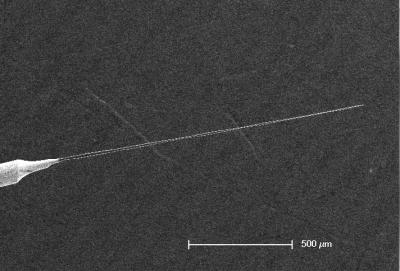Carbon nanotube electrode senses individual neuron signals
June 20, 2013

This image, taken with a scanning electron microscope, shows a new brain electrode that tapers to a point as thick as a single carbon nanotube (credit: Credit: Inho Yoon and Bruce Donald, Duke)
Neuroscientists have developed a new brain electrode that is a millimeter long, only a few nanometers wide and harnesses the superior electromechanical properties of carbon nanotubes to capture electrical signals from individual neurons.
“To our knowledge, this is the first time scientists have used carbon nanotubes to record signals from individual neurons, what we call intracellular recordings, in brain slices or intact brains of vertebrates,” said Bruce Donald, a professor of computer science and biochemistry at Duke University who helped develop the probe.
He and his collaborators describe the carbon nanotube probes June 19 in PLoS ONE (open access).
Scientists want to study signals from individual neurons and their interactions with other brain cells to better understand the computational complexity of the brain.
Currently, they use two main types of electrodes, metal and glass, to record signals from brain cells. Metal electrodes record spikes from a population of brain cells and work well in live animals. Glass electrodes also measure spikes, as well as the computations individual cells perform, but are delicate and break easily.
Sensing individual brain cells
“The new carbon nanotubes combine the best features of both metal and glass electrodes. They record well both inside and outside brain cells, and they are quite flexible. Because they won’t shatter, scientists could use them to record signals from individual brain cells of live animals,” said Duke neurobiologist Michael Platt, who was not involved in the study. The new probe also penetrates individual neurons, recording the signals of a single cell rather than the nearest population of them.
In the past, other scientists have experimented with carbon nanotube probes. But the electrodes were thick, causing tissue damage, or they were short, limiting how far they could penetrate into brain tissue. They could not probe inside individual neurons.
To make the probe, the scientists used the tip of an electrochemically sharpened tungsten wire as the base and extended it with self-entangled multi-wall carbon nanotubes to create a millimeter-long rod. The scientists then sharpened the nanotubes into a tiny harpoon using a focused ion beam at North Carolina State University.
The results show that the probe transmits brain signals as well as, and sometimes better than, conventional glass electrodes and is less likely to break off in the tissue.
Applications range from basic science to human brain-computer interfaces and brain prostheses.
This research was supported by the Duke Institute for Brain Sciences, and grants from the National Institutes of Health.